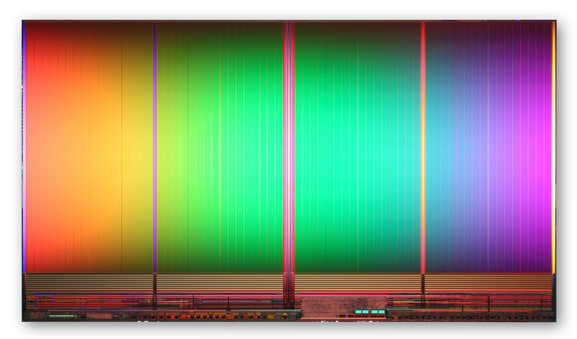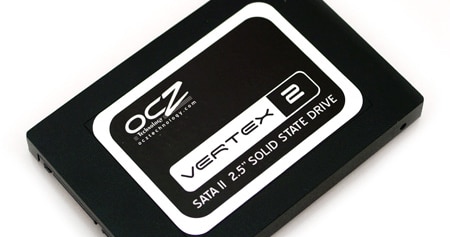The storage market is seeing new technology hit the retail shelves, but for most consumers it doesn’t mean faster drives or greater reliability. SSD manufacturers are starting to release drives with 25nm NAND flash, the newest type of flash memory, which is cheaper to make but offers fewer write cycles than the current-generation 34nm NAND. OCZ was the first mainstream SSD provider to shift to 25nm NAND, doing so largely in the dark – that is, unless you recently purchased a Vertex 2 or Agility 2 that was under 180GB. In that case, you may be intimately familiar with some of the "new features" of 25nm NAND and OCZ’s controversial marketing decisions. But first let’s take a step back.

The SSD industry is shifting from 34nm NAND in favor of the smaller chips, in part to rising costs as manufacturers scale back production of the older flash. Sure, the smaller NAND takes up less space and allow for (eventually) larger capacity SSDs – but the big deal is price, currently 25nm NAND costs 10-15% less than 34nm NAND. The topic is critical at just this moment because even though OCZ was first to launch 25nm SSDs, more drives are coming as early as this week, and SSD buyers need the inside scoop on how the SSD industry is changing.
Consumers will surely rejoice then at the thought of cheaper NAND leading to cheaper SSDs. Well, not so fast. While prices will continue to slide over time, don’t expect to see NewEgg and other retailers slashing the prices by 10% right away. With the drop in price, users will eventually see higher capacity drives for roughly what they are paying right now, but in the short term, usable capacities will actually drop.
The reason behind this is simple; 34nm MLC NAND is good for 5,000 write cycles, while 25nm MLC NAND lasts for only 3,000 write cycles. To account for this drop in individual cell lifespan, manufacturers increase the amount of reserve capacity that replaces worn sections as the drive degrades. In layman’s terms, an unformatted 120GB SSD with 25nm NAND is now 115GB (107GB available in Windows) compared to 120GB (111GB available in Windows) with 34nm NAND. Practically though, this change in write cycles should have little effect on SSD longevity for most users, with warranties and expected life spans staying the same. Most consumers won’t write enough data to notice the difference over the course of an SSD’s life. Some customers may feel cheated by this though, although the main concern is the loss of usable space, or more accurately, the marketing of the space available on a drive.

And so we get back to the issues swirling around OCZ and their marketing of the Vertex 2 and Agility 2 lines of SSDs. OCZ made the switch to 25nm NAND last week. The only problem is they didn’t make any branding or packaging changes. The net result, is consumers are getting a product with a fundamental technology change and a material change in capacity for drives under 180GB. Customers pay the same price for a smaller capacity drive and OCZ nets higher profits with the reduced cost of the smaller 25nm flash. As noted, a 120GB drive goes to 115GB, but it gets worse the smaller you get. A 60GB turns into 56GB and a 40GB into 36GB. It really hurts if you go the boot-drive SSD route, where every last megabyte is needed with an average Windows 7 install with a few applications included. You lose roughly 4-5GB for enhanced wear leveling and the smaller capacity drives see the largest percentage versus total capacity taken away. OCZ is comfortable with leaving the brand names as-is and has no plans to be more transparent to the user when it comes to usable SSD capacity. Buyers of the OCZ SSDs are rightfully displeased.
Looking past longevity concerns or reduced capacity, another thing consumers need to be aware of is making sure they know which SSD model they are buying if they plan on setuping up a RAID array. To give a quick example, when working with RAID0, 1, and 5, the smallest drive size is used when creating the array. So say you are using an older 40GB SSD with a newer 36GB model, you are now stuck with a 72GB RAID0 array instead of 80GB.
Other SandForce licensees we talked to have different 25nm launch plans. At least two vendors that we spoke are rolling out 25nm NAND SandForce SF-1200 drives in the next few weeks and are changing their marketing and/or drive branding to reflect the reduced capacity. We also talked to Intel about their plans, and they confirmed that only "user capacity" will be marketed on their SSDs.
How exactly this plays out remains to be seen, but we err in favor of transparency and hope the new 25nm SSDs are properly marketed to reflect usable capacity, especially in the case where multiple drives share nearly identical components, like controller and NAND makeup. Before you go out and buy a new SSD, be informed. StorageReview.com will stay on top of this issue and as always, feel free to post questions or comments about these issues in our SSD forums.
Update
We have both a brand new 32nm and 25nm Vertex 2 (60GB) and are testing them now. The 25nm is tracking slower, but we’ll have the full review up soon. Add any questions or areas you want to see addressed in the forums thread linked below.
Update 2
Our review comparing the 25nm Vertex 2 and the 32nm Vertex 2 is now live.
Update 3
OCZ is now offering free replacements for their 25nm SSDs.




 Amazon
Amazon